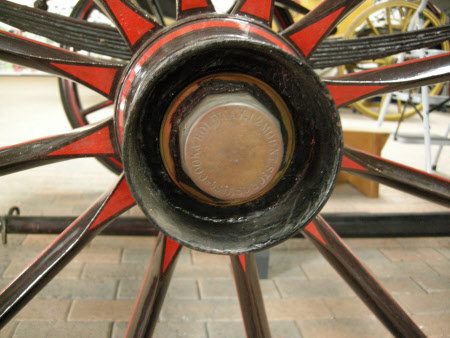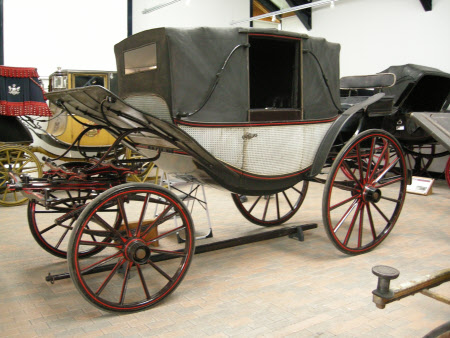Landau
Cook & Holdaway
Category
Carriages & other vehicles
Date
Unknown
Materials
Painted wood body with leather hood, wool cloth and morocco leather upholstery and four rubber shod wheels.
Measurements
227.5 x 418.5 x 178.5cm (7ft 5 1/2in x 13ft 8 3/4in x 5ft 10 1/4in)
Place of origin
London
Order this imageCollection
National Trust Carriage Museum
NT 272959.1
Caption
Postillion landaus were used for travelling or ceremonial purposes. This is known as an Ascot Landau and was one of eight similar carriages used in the Royal Ascot procession. Five are still kept at Windsor. Her majesty always rides in the first landau, which is pulled by a team of grey horses, the others are pulled by bays. Where there was no coachman’s seat, the horses were driven postillion. This was when a rider sat on the back of the left-hand horse to control the team. The pair of horses nearest the carriage are called the wheelers' and the other pair are the ‘leaders’.
Summary
Postillion Landau built by Cook & Holdaway, London. Originally in the Royal Mews collection. Postillion Landau (four wheels) for a pair of horses. Very elegant postillion landau with slight step piece character in the body, on elliptic springs in front and three springs behind. The front of the body is supported on side scroll irons to transom and horn bar, and a heavy centre stay to horn bar. There are curved stays from the back of the body supported by a cross spring. This carriage has a very large dashboard combined with front wings, with slight triple curvature and separate curved hind wings. The hind boot is of panelled construction with fixed seat back and leather squabs to seat rail. The heel board and boot top board missing. The leather heads are on curved joints. Interior upholsterd in blue wool cloth and black morocco leather. Painted in black with sham canework, wheels in maroon with red lining.
Full description
This landau was originally from the Royal Mews and brought to Edinburgh for ceremonial use in 1953. It was left there in the care of the transport section of St Cuthbert's Co-operative Society (later Scotmid) and was either sold to them or kept by them in lieu of garaging charges. Scotmid sold the carriage in 1994 or 1995 to West Lothian District Council which intended the carriage to form part of a carriage museum then planned for Hopetoun House as a tourist attraction. (The purchase was aided by the National Fund for Acquisitions administered by the National Museums of Scotland.) The museum was never created and public access to the collection became difficult following various alterations to the out buildings at Hopetoun - hence the decision to disperse the collection. A landau has the same profile as a coach and, like a coach, the body is symmetrical about a door in the middle of each side, and has a forward-facing internal seat behind the doors and a backward-facing seat ahead of them. The essential difference is that a coach has a fixed roof whereas a landau has a folding leather head in two parts, joined over the doors, that can be lowered front and back. Postillion-driven carriage were used either for travelling, when they made use of the posting system, or for ceremonial purposes for which they are ideal, and landaus are particularly suitable because, with the head lowered, the occupants are fully visible to the watching crowds. The Royal Mews still has a fleet of five postillion landaus suspended on C springs and under springs with perch undercarriages, that they call semi-state landaus as opposed to the state landaus that are coachman-driven. They also have five slightly lighter landaus suspended on elliptic springs in front and three springs, Dennett-style, behind. They have sham cane on their panels which gives them a less formal and summer country style. Because they are always used for the royal procession down the course before racing on each day of the Royal Ascot meeting, they are known as the Ascot landaus and are kept at Windsor Castle. Her majesty always rides in the first landau, which is pulled by four greys preceded by two outriders, also on greys. The other landaus are pulled by bays. Many years ago there were eight of these carriages and this is one of the three that were disposed of.
Marks and inscriptions
On front nearside axle cap.: COOK & HOLDAWAY, 12 MOUNT STREET AND GROS’VR SQ On front offside axle cap.: COOK & HOLDAWAY, 12 MOUNT STREET AND GROS’VR SQ On rear nearside axle cap.: COOK & HOLDAWAY, 12 MOUNT STREET AND GROS’VR SQ On rear offside axle cap.: COOK & HOLDAWAY, 12 MOUNT STREET AND GROS’VR SQ On nearside panel blind.: COOK & HOLDAWAY, COACHMAKERS TO HER MAJESTY, MOUNT ST. GROS’VR SQE On front nearside axle components.: 15300 MASON PATENT LONDON On front offside axle components.: 15300 MASON PATENT LONDON On rear nearside axle components.: 15300 MASON PATENT LONDON On rear offside axle components.: 15300 MASON PATENT LONDON
Makers and roles
Cook & Holdaway, coach builder


